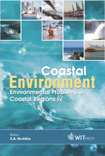Modelling Of Nutrient Transport In The Ebro Estuary (Spain)
Price
Free (open access)
Transaction
Volume
58
Pages
Published
2002
Size
440 kb
Paper DOI
10.2495/CENV020221
Copyright
WIT Press
Author(s)
E K Rasmussen, M Peirup, B Hasholt, P A Figueras, J P Sierra & P S Rosshaug
Abstract
A two layer combined hydrodynamic and nutrient model (MIKE 12 from DHI) has been set up for the lower part of the Ebro River. The model was used to simulate the concentrations and transport of nitrogen, phosphorus and organic matter, from the last monitoring station at Tortosa, 42 km upstream the entrance, to the Mediterranean. The model set up includes the Ebro Delta and the estuarine part of the system where a salt wedge during summer typically penetrates 20 km upstream the entrance. The location of the wedge depends on the discharge in the river. While the salt wedge is present, entrainment between bottom and surface water drives a net influx of high saline water with relatively low nutrient concentrations into the salt wedge from the sea. Due to flocculation and sedimentation in the estuarine part, particulate bound nutrients enter the wedge resulting in an enrichment of the lower layer of suspended matter and particulate organic nutrients. The nutrient part of the model system includes N and P nutrients, phytoplankton and detritus carbon. The module uses a selected part of DHI's mud transport model to simulate sedimentation, resuspension and transport of particulate detritus carbon nitrogen and phosphorus. The model has been run for one year using monthly monitoring data on water chemistry at Tortosa as upper boundary condition. A nutrient mass budget for the period from 15.02.99 to 15.02.00 gives a net transport to the sea of 20,000 tonnes N and 1,000 tonnes total P. The model result shows that the salt wedge act as a sediment trap for fine (organic) sediment during summer. In winter the fine sediment is resuspended when the salt wedge is pressed towards the mouth.
Keywords





